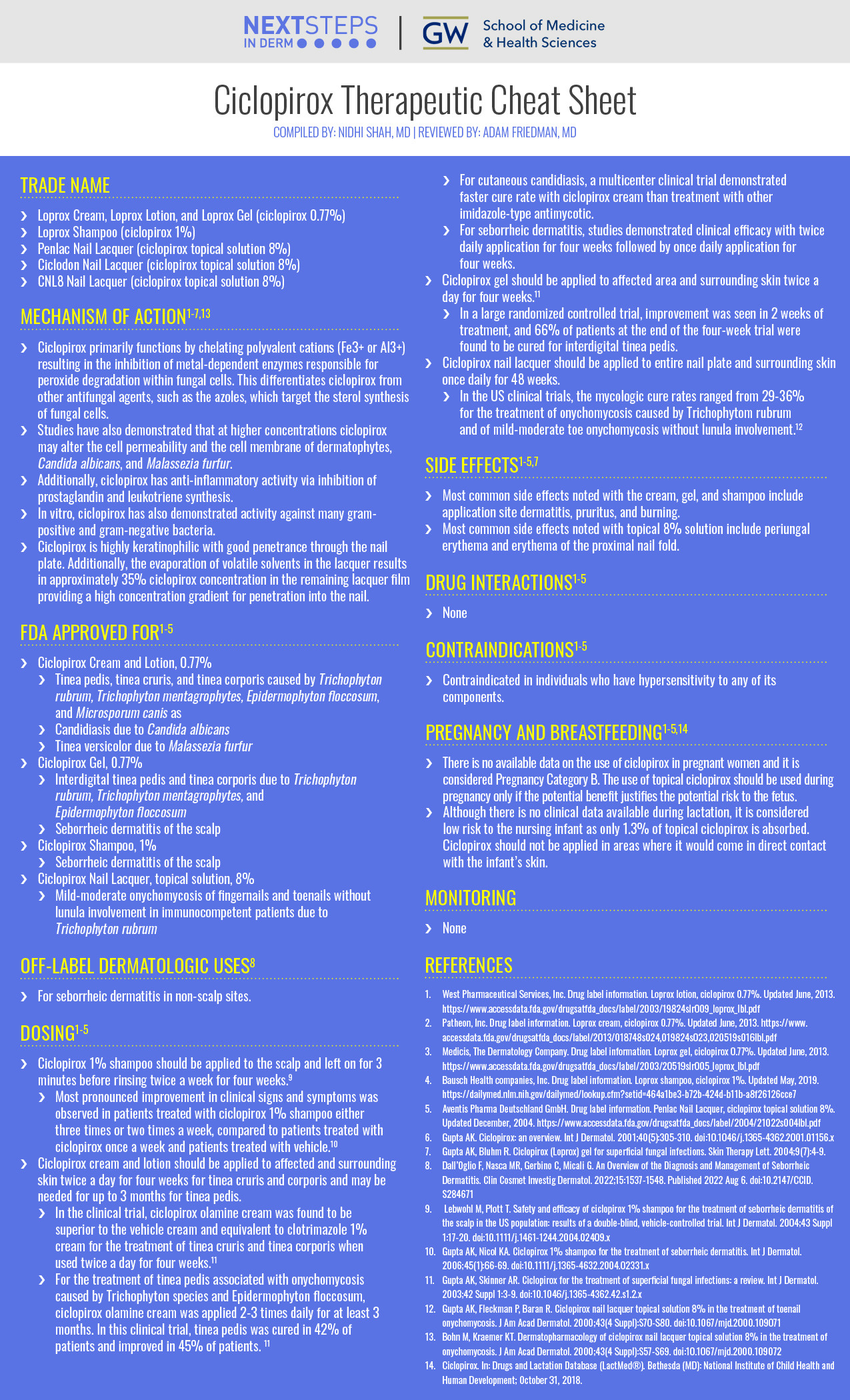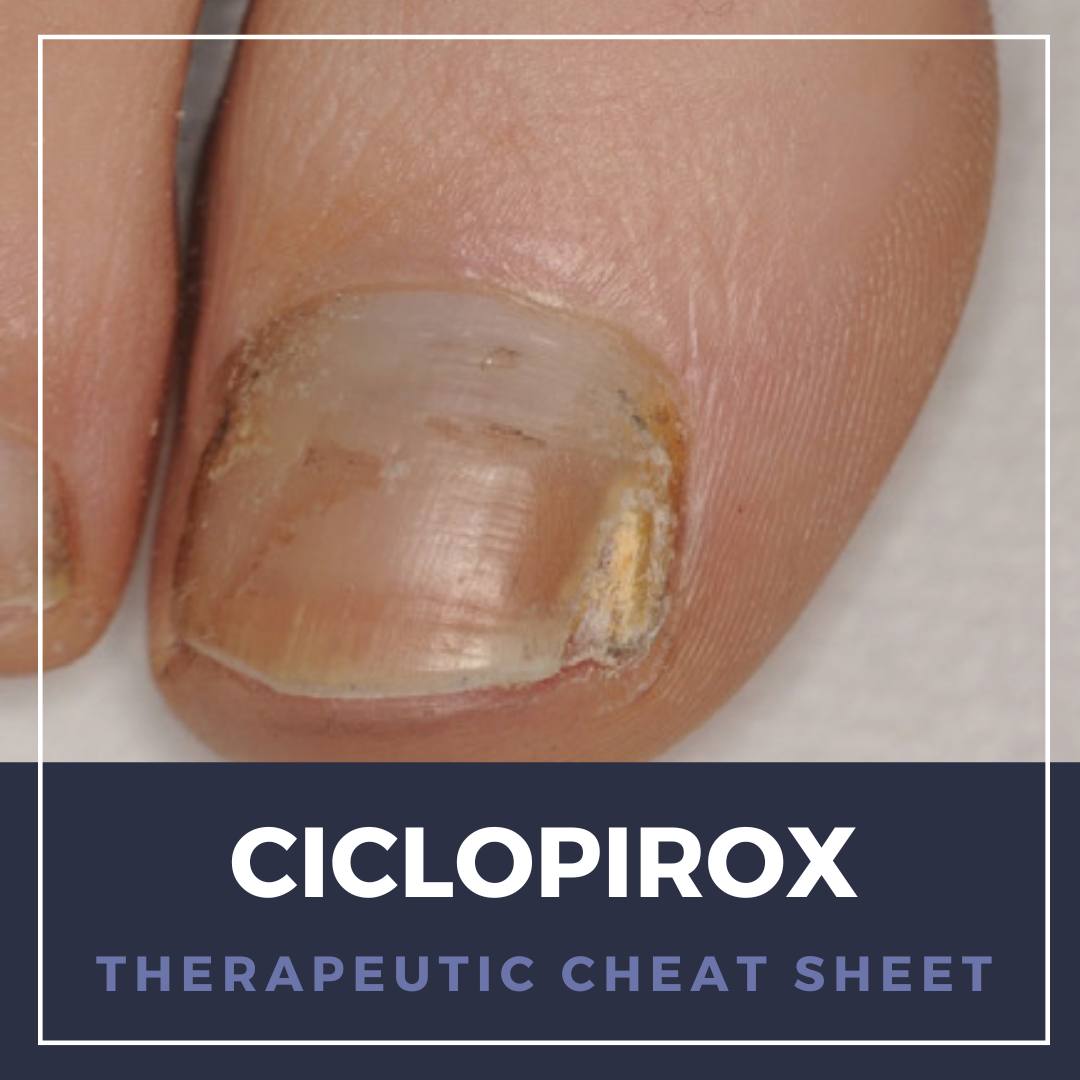Ciclopirox is the only hydroxypyridone antifungal agent with a unique mechanism of action differentiating it from other antimycotic agents. Unlike the azole-antifungals which block the sterol synthesis in the fungal cell membrane, ciclopirox functions by chelating cations resulting in the degradation of fungal cells, as well as proposed anti-inflammatory properties. It is available in a variety of formulations and its safety profile allows for expansion of its utilization targeting dermatophytes, Candida albicans, and Malassezia furfur. We continue our series, Therapeutic Cheat Sheet, with a closer look at ciclopirox, which is FDA-approved for the treatment of dermatologic conditions such as superficial dermatophyte infections, onychomycosis, and seborrheic dermatitis.
Ciclopirox Therapeutic Cheat Sheet
Compiled by: Nidhi Shah, MD | Reviewed by: Adam Friedman, MD
TRADE NAME
-
- Loprox Cream, Loprox Lotion, and Loprox Gel (ciclopirox 0.77%)
- Loprox Shampoo (ciclopirox 1%)
- Penlac Nail Lacquer (ciclopirox topical solution 8%)
- Ciclodon Nail Lacquer (ciclopirox topical solution 8%)
- CNL8 Nail Lacquer (ciclopirox topical solution 8%)
MECHANISM OF ACTION1-7,13
-
- Ciclopirox primarily functions by chelating polyvalent cations (Fe3+ or Al3+) resulting in the inhibition of metal-dependent enzymes responsible for peroxide degradation within fungal cells. This differentiates ciclopirox from other antifungal agents, such as the azoles, which target the sterol synthesis of fungal cells.
- Studies have also demonstrated that at higher concentrations ciclopirox may alter the cell permeability and the cell membrane of dermatophytes, Candida albicans, and Malassezia furfur.
- Additionally, ciclopirox has anti-inflammatory activity via inhibition of prostaglandin and leukotriene synthesis.
- In vitro, ciclopirox has also demonstrated activity against many gram-positive and gram-negative bacteria.
- Ciclopirox is highly keratinophilic with good penetrance through the nail plate. Additionally, the evaporation of volatile solvents in the lacquer results in approximately 35% ciclopirox concentration in the remaining lacquer film providing a high concentration gradient for penetration into the nail.
FDA APPROVED FOR1-5
Ciclopirox Cream and Lotion, 0.77%
-
-
- Tinea pedis, tinea cruris, and tinea corporis caused by Trichophyton rubrum, Trichophyton mentagrophytes, Epidermophyton floccosum, and Microsporum canis as
- Candidiasis due to Candida albicans
- Tinea versicolor due to Malassezia furfur
-
Ciclopirox Gel, 0.77%
-
- Interdigital tinea pedis and tinea corporis due to Trichophyton rubrum, Trichophyton mentagrophytes, and Epidermophyton floccosum
- Seborrheic dermatitis of the scalp
Ciclopirox Shampoo, 1%
-
- Seborrheic dermatitis of the scalp
Ciclopirox Nail Lacquer, topical solution, 8%
-
- Mild-moderate onychomycosis of fingernails and toenails without lunula involvement in immunocompetent patients due to Trichophyton rubrum
OFF-LABEL DERMATOLOGIC USES8
-
- For seborrheic dermatitis in non-scalp sites.
DOSING1-5
-
- Ciclopirox 1% shampoo should be applied to the scalp and left on for 3 minutes before rinsing twice a week for four weeks.9
- Most pronounced improvement in clinical signs and symptoms was observed in patients treated with ciclopirox 1% shampoo either three times or two times a week, compared to patients treated with ciclopirox once a week and patients treated with vehicle.10
- Ciclopirox cream and lotion should be applied to affected and surrounding skin twice a day for four weeks for tinea cruris and corporis and may be needed for up to 3 months for tinea pedis.
- In the clinical trial, ciclopirox olamine cream was found to be superior to the vehicle cream and equivalent to clotrimazole 1% cream for the treatment of tinea cruris and tinea corporis when used twice a day for four weeks.11
- For the treatment of tinea pedis associated with onychomycosis caused by Trichophyton species and Epidermophyton floccosum, ciclopirox olamine cream was applied 2-3 times daily for at least 3 months. In this clinical trial, tinea pedis was cured in 42% of patients and improved in 45% of patients. 11
- For cutaneous candidiasis, a multicenter clinical trial demonstrated faster cure rate with ciclopirox cream than treatment with other imidazole-type antimycotic.
- For seborrheic dermatitis, studies demonstrated clinical efficacy with twice daily application for four weeks followed by once daily application for four weeks.
- Ciclopirox gel should be applied to affected area and surrounding skin twice a day for four weeks.11
- In a large randomized controlled trial, improvement was seen in 2 weeks of treatment, and 66% of patients at the end of the four-week trial were found to be cured for interdigital tinea pedis.
- Ciclopirox nail lacquer should be applied to entire nail plate and surrounding skin once daily for 48 weeks.
- In the US clinical trials, the mycologic cure rates ranged from 29-36% for the treatment of onychomycosis caused by Trichophytom rubrum and of mild-moderate toe onychomycosis without lunula involvement.12
- Ciclopirox 1% shampoo should be applied to the scalp and left on for 3 minutes before rinsing twice a week for four weeks.9
WARNINGS AND PRECAUTIONS1-5
-
- Only for topical use, not for ophthalmic, oral, or intravaginal use.
- If there is a reaction suggesting sensitivity or chemical irritation, the treatment should be discontinued.
SIDE EFFECTS1-5,7
-
- Most common side effects noted with the cream, gel, and shampoo include application site dermatitis, pruritus, and burning.
- Most common side effects noted with topical 8% solution include periungal erythema and erythema of the proximal nail fold.
DRUG INTERACTIONS1-5
-
- None
CONTRAINDICATIONS1-5
-
- Contraindicated in individuals who have hypersensitivity to any of its components.
PREGNANCY AND BREASTFEEDING1-5,14
-
- There is no available data on the use of ciclopirox in pregnant women and it is considered Pregnancy Category B. The use of topical ciclopirox should be used during pregnancy only if the potential benefit justifies the potential risk to the fetus.
- Although there is no clinical data available during lactation, it is considered low risk to the nursing infant as only 1.3% of topical ciclopirox is absorbed. Ciclopirox should not be applied in areas where it would come in direct contact with the infant’s skin.
MONITORING
-
- None

FURTHER READING
If you would like to learn more about Ciclopirox, check out the following articles in the Journal of Drugs in Dermatology:
Abstract
Onychomycosis is a prevalent condition affecting the United States and global population. Treatment options are limited, with only 3 topical anti-fungal medications garnering approval in the US within the last 25 years: ciclopirox, tavaborole, and efinaconazole. The economic impact and quality of life burden due to onychomycosis are high. Here we provide an up-to-date review of all approved topical anti-fungal therapies for toenail onychomycosis. We discuss treatment efficacies, pharmacology, and use in special populations, as well as current evidence for complementary and alternative medicine.
J Drugs Dermatol.2023;22:9(Suppl 1):s5-10.
An Up-to-Date Approach to the Management of Seborrheic Dermatitis
Abstract
Seborrheic dermatitis (SD) is a chronic, relapsing, inflammatory dermatosis with ambiguous pathophysiology of overcolonization of Malassezia combined with predisposing factors including sebocyte activity, impaired immunity with diminished T-cell responses and activation of complements, disruption of epidermal barrier integrity and skin microbiota, and environmental influences.
J Drugs Dermatol. 2022;21(12):1373-1374.
REFERENCES
-
- West Pharmaceutical Services, Inc. Drug label information. Loprox lotion, ciclopirox 0.77%. Updated June, 2013. https://www.accessdata.fda.gov/drugsatfda_docs/label/2003/19824slr009_loprox_lbl.pdf
- Patheon, Inc. Drug label information. Loprox cream, ciclopirox 0.77%. Updated June, 2013. https://www.accessdata.fda.gov/drugsatfda_docs/label/2013/018748s024,019824s023,020519s016lbl.pdf
- Medicis, The Dermatology Company. Drug label information. Loprox gel, ciclopirox 0.77%. Updated June, 2013. https://www.accessdata.fda.gov/drugsatfda_docs/label/2003/20519slr005_loprox_lbl.pdf
- Bausch Health companies, Inc. Drug label information. Loprox shampoo, ciclopirox 1%. Updated May, 2019. https://dailymed.nlm.nih.gov/dailymed/lookup.cfm?setid=464a1be3-b72b-424d-b11b-a8f26126cce7
- Aventis Pharma Deutschland GmbH. Drug label information. Penlac Nail Lacquer, ciclopirox topical solution 8%. Updated December, 2004. https://www.accessdata.fda.gov/drugsatfda_docs/label/2004/21022s004lbl.pdf
- Gupta AK. Ciclopirox: an overview. Int J Dermatol. 2001;40(5):305-310. doi:10.1046/j.1365-4362.2001.01156.x
- Gupta AK, Bluhm R. Ciclopirox (Loprox) gel for superficial fungal infections. Skin Therapy Lett. 2004;9(7):4-9.
- Dall’Oglio F, Nasca MR, Gerbino C, Micali G. An Overview of the Diagnosis and Management of Seborrheic Dermatitis. Clin Cosmet Investig Dermatol. 2022;15:1537-1548. Published 2022 Aug 6. doi:10.2147/CCID.S284671
- Lebwohl M, Plott T. Safety and efficacy of ciclopirox 1% shampoo for the treatment of seborrheic dermatitis of the scalp in the US population: results of a double-blind, vehicle-controlled trial. Int J Dermatol. 2004;43 Suppl 1:17-20. doi:10.1111/j.1461-1244.2004.02409.x
- Gupta AK, Nicol KA. Ciclopirox 1% shampoo for the treatment of seborrheic dermatitis. Int J Dermatol. 2006;45(1):66-69. doi:10.1111/j.1365-4632.2004.02331.x
- Gupta AK, Skinner AR. Ciclopirox for the treatment of superficial fungal infections: a review. Int J Dermatol. 2003;42 Suppl 1:3-9. doi:10.1046/j.1365-4362.42.s1.2.x
- Gupta AK, Fleckman P, Baran R. Ciclopirox nail lacquer topical solution 8% in the treatment of toenail onychomycosis. J Am Acad Dermatol. 2000;43(4 Suppl):S70-S80. doi:10.1067/mjd.2000.109071
- Bohn M, Kraemer KT. Dermatopharmacology of ciclopirox nail lacquer topical solution 8% in the treatment of onychomycosis. J Am Acad Dermatol. 2000;43(4 Suppl):S57-S69. doi:10.1067/mjd.2000.109072
- In: Drugs and Lactation Database (LactMed®). Bethesda (MD): National Institute of Child Health and Human Development; October 31, 2018.
Did you enjoy this Therapeutic Cheat Sheet? You can find more here.

